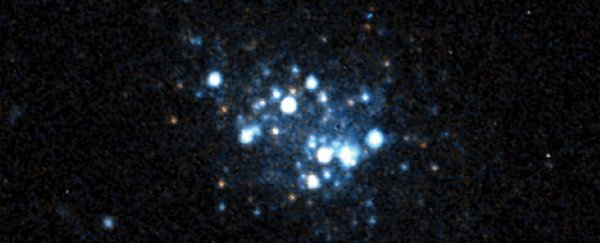Astronomers have discovered something unusual about a small blue galaxy located about 30 million light-years away from Earth, and the findings could offer a great opportunity to learn more about conditions in the Universe at the time of the Big Bang.
The galaxy in question is called AGC 198691, and it was discovered a few years ago as part of the Arecibo Legacy Fast ALFA survey. But a team of researchers from Indiana University has now found that this dwarf galaxy actually contains the lowest level of heavy elements ever detected in a gravitationally bound system of stars. In the context of astronomy, heavy elements or 'metals' refers to any element other than hydrogen or helium.
It's a big find, beating out the previous record-holder – a galaxy called SBS 0335–052W – with an estimated 29 percent lower metal abundance overall. The reason why galaxies with such low levels of 'metals' are important is because the composition of these metal-poor star systems is thought to be similar to the elemental conditions of the Universe shortly after the Big Bang.
In other words, even though AGC 198691 – nicknamed Leoncino ("little lion") by the Indiana team, after the Italian-born radio astronomer, Riccardo Giovanelli – is some 30 million light-years away, it offers the best known test case to study the way the Universe was in its long-ago youth.
"Finding the most metal-poor galaxy ever is exciting since it could help contribute to a quantitative test of the Big Bang," said one of the researchers, John J. Salzer. "There are relatively few ways to explore conditions at the birth of the Universe, but low-metal galaxies are among the most promising."
The Milky Way doesn't offer a similar way of studying pseudo-Big-Bang science by observation, as billions of years of star activity have ended up churning out high levels of heavy elements. This happens through a phenomenon called 'stellar processing', in which stars generate and distribute heavy elements through galaxies over their lifetime.
"Low metal abundance is essentially a sign that very little stellar activity has taken place compared to most galaxies," said one of the team, Alec S. Hirschauer.
But unlike the crowded Milky Way – containing an estimated 200 billion to 400 billion stars – 'Leoncino' is a dwarf galaxy, measuring just 1,000 light-years in diameter and home to only several million stars, which could help explain its record lows when it comes to metal elements.
And, yep, encompassing several millions stars makes it seem pretty gargantuan to you and me, but in terms of star systems, this thing is a minnow – albeit a minnow of considerable scientific value, now that we've found out about its metal-poor makeup.
"We're eager to continue to explore this mysterious galaxy," said Salzer. "Low-metal-abundance galaxies are extremely rare, so we want to learn everything we can."
The findings are reported in The Astrophysical Journal.
